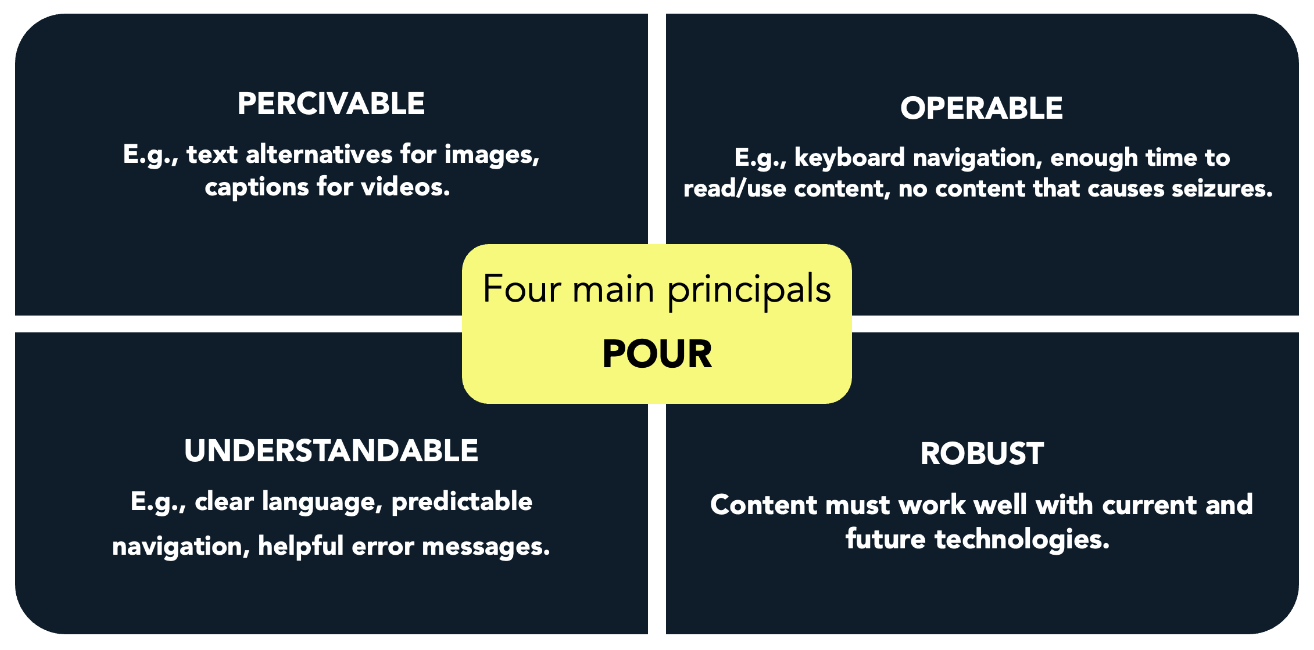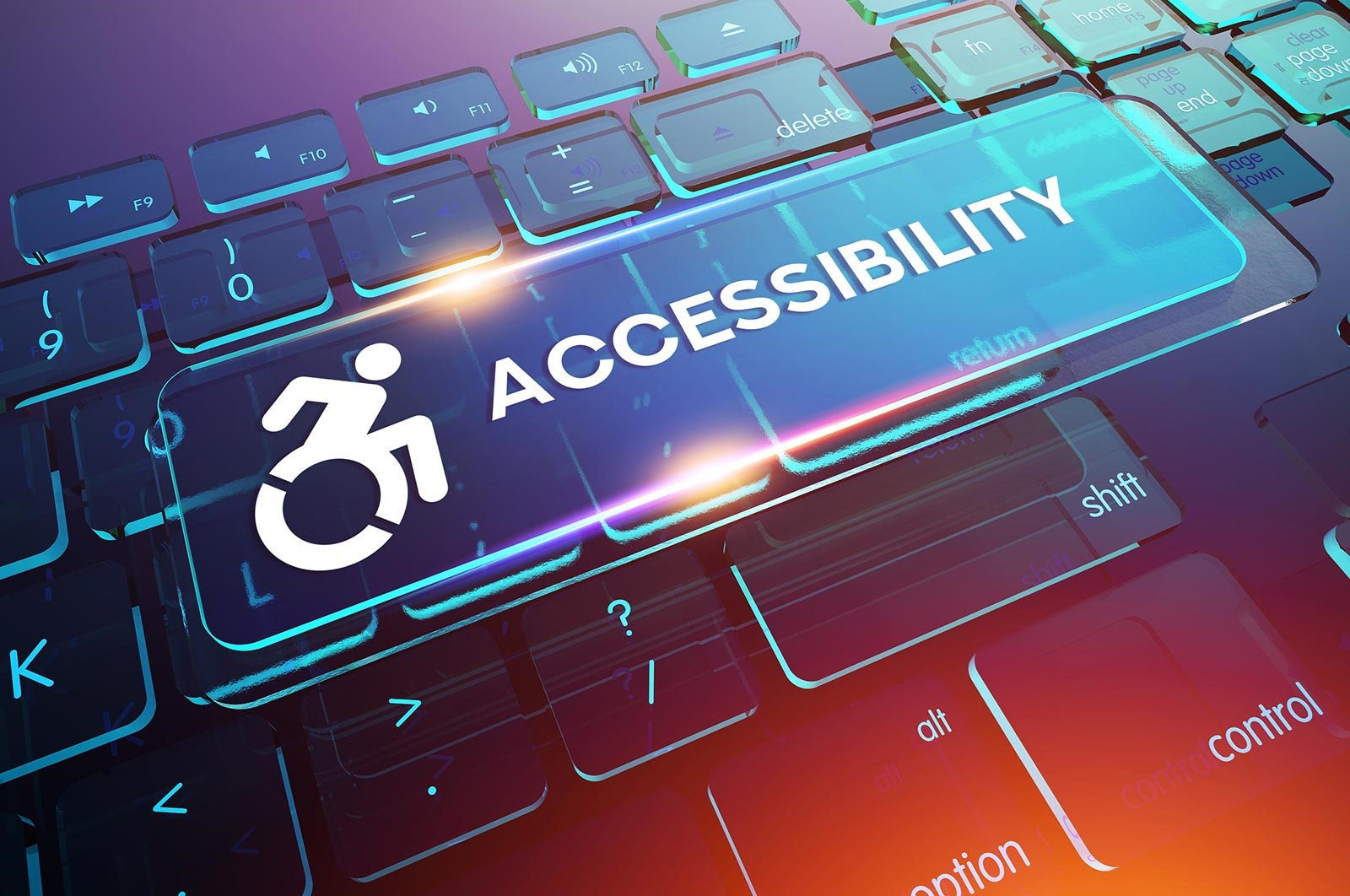
What is WCAG 2.1?
Web Content Accessibility Guidelines 2.1 is a set of international standards developed by the World Wide Web Consortium (W3C) to make web content more accessible to people with disabilities, including those with visual, auditory, motor, and cognitive impairments. It ensures websites and digital content are usable by everyone, promotes inclusivity, helps organizations meet legal requirements, and improves overall user experience.
The four main principles of WCAG 2.1 are summarized by the acronym POUR:

WCAG 2.1 defines three levels of conformance to help organizations prioritize and structure their accessibility efforts:
| Levels | Description | Example |
| Level A | The most basic web accessibility features. These are the minimum requirements that must be met to ensure some level of access for users with disabilities. | Videos must include captions. |
| Level AA | The mid-range level that addresses the biggest and most common accessibility barriers. This is the legal requirement for most public sector websites in the EU under the Web Accessibility Directive and national laws like the DOS Act. | Videos should also include audio description (narration of visual elements). |
| Level AAA | The highest level of accessibility, representing the most comprehensive and inclusive standards. Achieving AAA is often seen as a best-practice goal for content that serves users with more specific needs. | Videos should additionally offer sign language interpretation. |
Why should I include WCAG in my development?
Legal Consequences
In many countries, including EU member states, accessibility regulations are tied to disability rights laws. For example the Web Accessibility Directive applies to public sector websites and mobile applications across all EU member states. Since 2019, it has been a legal requirement that these digital services comply with WCAG 2.1 Level AA*.
Organizations that do not make their digital content accessible and fail to comply with WCAG 2.1, may face financial penalties, court orders to remediate their websites, and damage to their reputation. Ensuring compliance helps avoid legal risks and supports inclusive access for all users.
Business Benefits
Beyond legal protection, implementing WCAG 2.1 brings clear business advantages. Accessible websites reach a wider audience, including millions of people with disabilities and older users. This can lead to increased traffic, better customer satisfaction, and higher conversion rates. Accessible design also improves SEO, mobile usability, and overall user experience for everyone—not just those with disabilities. In short, accessibility is not only the right thing to do, but also a smart investment in broader market reach and brand reputation.
 Image: Sketchplanations
Image: Sketchplanations
Future trends
Moving in to the near future, The European Accessibility Act (EAA – Directive 2019/882) expands accessibility obligations to include private sector companies in specific industries. Taking effect on 28 June 2025, the EAA mandates that certain products and services must be accessible to people with disabilities across the EU. These include:
- E-commerce and online stores
- Banking services and ATMs
- Transportation services (ticket machines, check-in systems)
- E-books and e-readers
- Telecommunications and smartphones
- TV-related equipment and digital services
Accessibility testing is no longer a niche concern—it’s a critical part of delivering high-quality digital experiences. As WCAG 2.1 becomes increasingly embedded in legislation like the Web Accessibility Directive and the upcoming European Accessibility Act, organizations must take proactive steps to ensure compliance. But beyond legal mandates, accessibility is about equity, dignity, and usability for all.
By integrating WCAG 2.1 into your testing strategy, you don’t just meet technical checkboxes—you make a genuine difference in people’s lives. Accessible design opens digital doors for users with disabilities, improves usability for everyone, and builds stronger, more inclusive brands. As testers, developers, and designers, we have both the responsibility and the opportunity to shape a digital world that welcomes everyone. Let’s treat accessibility not as an obligation, but as a fundamental part of doing good work.
Accessibility and quality assurance
For many teams, the introduction of WCAG into their development life cycle, can be a complex one. In order to provide their end users with accessible digital products, there's many areas that needs to be considered, improved and tested.
If you want to learn more about the important areas according to WCAG 1.2 and how it effects implementing a test strategy, read the next part of the blog here.
If you have any questions regarding this topic, or your company needs guidance, please don't hesitate to contact us.






